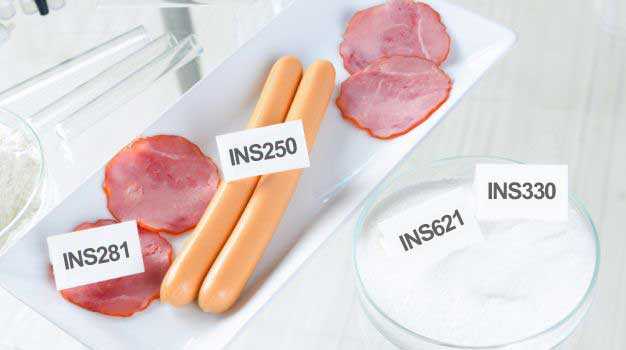
Sal de cura causa câncer?
Não é o sal de cura(nitrito e/ou nitrato) em si que está associado ao câncer, mas sim as nitrosaminas, que são um composto secundário que, em determinadas circunstâncias, incluindo o nosso estômago, podem ser formadas no corpo humano pelo consumo do nitrito. Sabendo disso, a principal pergunta é: qual é a maior fonte de nitrito e nitrato na nossa alimentação?
Nitrato e Nitrito no corpo humano
Nitrato e nitrito são sintetizados pelo metabolismo humano. O nitrato produzido pelo metabolismo humano é secretado pela saliva. O nitrato é reduzido quimicamente em nitrito por bactérias presentes na boca. Normalmente, cerca de 20% do nitrato produzido pela saliva e ingerido na alimentação é convertido em nitrito. Essa conversão representa mais de 90% do total de nitrito ingerido, o restante provém de fontes externas ao corpo(comidas e bebidas).
Em um estudo nos Estados Unidos(A National Survey of the Nitrite/Nitrate Concentrations in Cured Meat Products and Nonmeat Foods Available at Retail – NPB #08-124), realizado por institutos de medicina, universidades e órgãos de saúde, que teve como objetivo analisar as fontes de nitrito e nitrato na dieta norte americana, avaliou as fontes provenientes de diversos vegetais e frutas. Neste estudo, 467 produtos cárneos e 197 amostras de frutas e verduras foram retirados de pontos de venda em cinco grandes cidades e analisadas quanto ao teor de nitrito e nitrato (ppm). Segue o resultado abaixo.
A concentração de nitrito/nitrato em vegetais, segundo o estudo norte americano de 2009, notou diferenças em vegetais convencionais e orgânicos retirados de cinco cidades metropolitanas. Os níveis de nitrato de brócolis, repolho, aipo, alface e espinafre foram de 394,38, 417,56, 1.495,48, 850,46 e 2.797,18 ppm, respectivamente, enquanto suas versões orgânicas tiveram uma média de 204,29, 551,97, 911,94, 844,06 e 1.317,73 ppm. Para se ter uma comparação, o nitrito residual permitido em um produto cárneo processado no Brasil é de 150ppm, enquanto o espinafre orgânico tem mais de 1300 ppm de nitrato naturalmente presente.
O estudo conclui que os vegetais contribuem por 80% da ingestão de nitratos na dieta norte americana.
Já para o Canadense CMC(Canadian Meat Concil) menciona que os vegetais constituem, de longe, a maior fonte de nitrato na dieta humana, provendo mais de 85% da ingestão diária. Adicionalmente, nitrato e nitrito são sintetizados pelo metabolismo humano. O nitrato produzido pelo metabolismo humano é secretado pela saliva. O nitrato é reduzido quimicamente em nitrito por bactérias presentes na boca. Normalmente, cerca 20% do nitrato produzido pela saliva e alimentação é convertido em nitrito. Essa conversão representa mais de 90% do total de nitrito ingerido, o restante provém de fontes externas ao corpo.
Fontes de nitrito e nitrato
Os vegetais com as maiores concentrações de nitrato, de 1.000 a 2.500ppm, são:
- Escarola;
- Alface;
- Espinafre;
- Beterraba vermelha;
- Rabanete;
- Aipo;
- Ruibarbo;
- Salsa;
- Acelga;
- Nabo.
Vegetais com concentração média, de 500 a 1.000 ppm), incluem:
- Repolho;
- Alho-poró;
- Abóbora.
Exemplos de baixa concentração, de 200 a 500 ppm, são:
- Brócolis;
- Cenoura;
- Pepino;
- Couve-flor;
- Berinjela;
- Cebolinha;
- Melão.
Outros alimentos com menos de 200ppm são:
- Batata;
- Pimentão;
- Batata doce;
- Tomate.
Nitrito e nitrato em carnes processadas
Os resultados publicados pelo estudo norte americano apontam que:
As médias ponderadas dos níveis de nitrito e nitrato em todas as categorias de carnes processadas foram de 4,54 e 37,07 ppm.
Os níveis mais baixos de nitrito no estudo norte americano foram observados em produtos cárneos fermentados, curados a seco, com média entre 0,64 e 1,95 ppm. Níveis mais altos de nitrito foram observados para salsichas e músculos inteiros cozidos e não cozidos, com média entre 6,86 e 7,31 ppm.
Conclusão
O nitrito e o nitrato fazem parte da uma dieta balanceada independentemente do consumo de carnes processadas. Vegetais, frutas e até água contém estes compostos, não há como escapar deles. É preciso moderação ao consumir qualquer alimento, incluindo as carnes processadas que podem conter riscos não apenas pela presença do nitrito e nitrato, mas principalmente pela quantidade de sal e gordura, que dependendo da condição de saúde do indivíduo pode ser o maior problema.
Referências
Time-dependent depletion of nitrite in pork/beef and chicken meat products and its effect on nitrite intake estimation
A National Survey of the Nitrite/Nitrate Concentrations in Cured Meat Products and Nonmeat Foods Available at Retail – NPB #08-124
Canadian Meat Council
Changes in residual nitrite in sausage and luncheon meat products during storage



